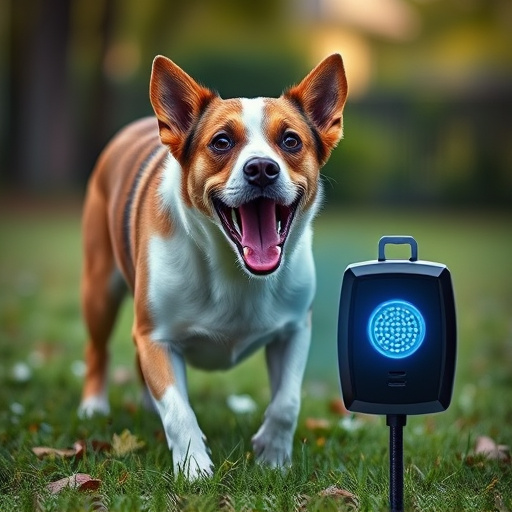Sonic animal training safety devices offer humane alternatives to repellents, using high-frequency sound waves or scents to keep dogs and cats away. Stationary models are ideal for fixed locations like patios (energy efficiency, quiet operation, consistency) while mobile repellents provide versatility for outdoor activities (camping, farming). Stationary systems emit sounds/scents for controlled protection in gardens, patios, etc., without altering dog paths. Mobile systems offer flexibility, adjusting based on changing needs in dynamic environments. Choosing between them depends on coverage area, ease of use, environmental impact, and potential effects on other pets or wildlife.
“Unleash a safer, more effective training experience with Sonic Animal Training Safety Devices. This comprehensive guide delves into the world of dog repellents, exploring both stationary and mobile solutions. Discover how these innovative tools help train pets without resorting to traditional, potentially harmful methods. Weigh the benefits and applications of stationary dog repellent systems, from increased control to their environmental impact. Then, learn about mobile options, their advantages, and considerations for various training scenarios. Get ready to unlock the ultimate Stationary Vs Mobile Dog Repellent Comparison.”
- Understanding Sonic Animal Training Safety Devices: A Comprehensive Overview
- Stationary Dog Repellents: Benefits and Applications
- Mobile Dog Repellent Systems: Advantages and Considerations
- Comparison: Key Differences Between Stationary and Mobile Devices
Understanding Sonic Animal Training Safety Devices: A Comprehensive Overview
Sonic animal training safety devices have emerged as a revolutionary tool in pet care, offering a non-lethal alternative to traditional repellents. These devices use high-frequency sound waves to deter animals like dogs and cats from entering specific areas, making them ideal for both indoor and outdoor use. Understanding the difference between stationary and mobile versions is crucial when choosing the right fit for your needs.
Stationary models are typically installed at fixed locations, such as patios or garden borders, emitting a consistent sonic signal to keep animals away. They are energy-efficient, quiet, and effective in controlled environments. In contrast, mobile dog repellents are portable devices that can be moved from place to place, offering versatility for various scenarios like campgrounds or farms. This mobility allows for dynamic protection against wandering animals, making them a game-changer for outdoor activities.
Stationary Dog Repellents: Benefits and Applications
Stationary dog repellents offer a unique and effective approach to keeping canines at bay, especially in scenarios where mobility is restricted or desired. Unlike mobile options that rely on movement to deter dogs, stationary devices are designed to emit sounds, scents, or other stimuli that create an unpleasant experience for the animals without requiring them to change their path. This makes them ideal for areas like gardens, patios, and entryways, providing a more controlled and targeted solution.
In terms of a Stationary Vs Mobile Dog Repellent Comparison, stationary repellents have several advantages. They can be strategically placed in specific locations, ensuring consistent protection over time. Additionally, they are less disruptive to humans and other animals since they don’t involve constant triggering or movement. This makes them a preferred choice for homeowners seeking a humane yet effective way to manage dog intrusions without causing harm or distress.
Mobile Dog Repellent Systems: Advantages and Considerations
Mobile Dog Repellent Systems offer a flexible and efficient solution for managing unwanted canine behavior, especially in dynamic environments. Unlike stationary devices that are limited to fixed locations, mobile systems can be easily transported and adjusted according to changing needs. This advantage is particularly beneficial for outdoor spaces like parks, farms, or even during events where the need for deterring dogs may vary across different areas.
When considering a Stationary Vs Mobile Dog Repellent Comparison, it’s crucial to weigh factors such as coverage area, ease of use, and environmental impact. While stationary devices might provide broader coverage, they lack the versatility of mobile systems. However, mobile options should be carefully evaluated for their reliability, power sources, and potential effects on nearby wildlife or other pets. Effective mobile repellent systems strike a balance between portability and performance to ensure safe and humane behavior modification.
Comparison: Key Differences Between Stationary and Mobile Devices
When considering a Stationary vs Mobile Dog Repellent for training and safety, understanding key differences is vital. While both aim to deter unwanted behavior through sound, they operate distinctly. Stationary devices remain in a fixed location, typically using ultrasonic tones or scent-based repellents to signal to dogs that certain areas are off-limits. This makes them ideal for confined spaces like yards or specific rooms where consistency and predictability are crucial for effective training.
In contrast, mobile devices offer versatility by allowing users to actively move the device around, targeting specific behaviors or locations on demand. These often incorporate adjustable settings for tone volume and frequency, appealing to a wider range of dog sensitivities. Mobile options are excellent for managing behavior in larger areas, during walks, or when traveling, providing dynamic reinforcement as needed.
Sonic animal training safety devices, whether stationary or mobile, offer innovative solutions for pet owners. This comprehensive overview has highlighted the distinct benefits of each type, with stationary repelents excelling in controlled environments and mobile systems providing versatility for on-the-go training. When choosing between a stationary and mobile dog repellent, considering your pet’s behavior, environment, and specific training goals is key. Ultimately, both options can enhance training effectiveness while ensuring animal safety, allowing you to select the ideal device for your unique needs in our modern world.
